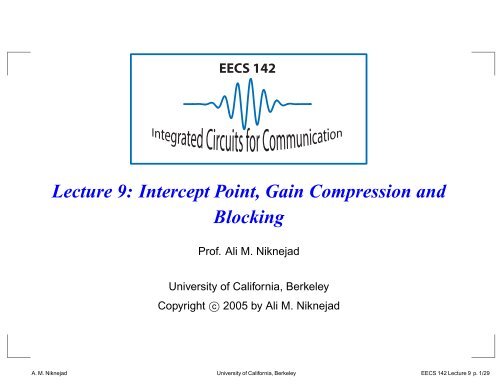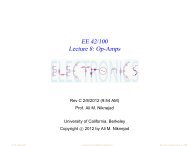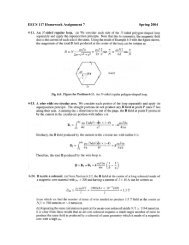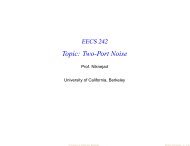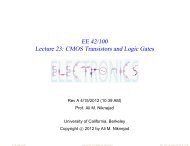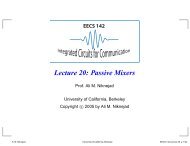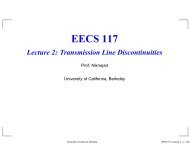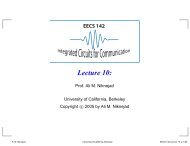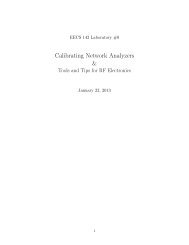Lecture 9: Intercept Point, Gain Compression and ... - Ali M. Niknejad
Lecture 9: Intercept Point, Gain Compression and ... - Ali M. Niknejad
Lecture 9: Intercept Point, Gain Compression and ... - Ali M. Niknejad
Create successful ePaper yourself
Turn your PDF publications into a flip-book with our unique Google optimized e-Paper software.
EECS 142<strong>Lecture</strong> 9: <strong>Intercept</strong> <strong>Point</strong>, <strong>Gain</strong> <strong>Compression</strong> <strong>and</strong>BlockingProf. <strong>Ali</strong> M. <strong>Niknejad</strong>University of California, BerkeleyCopyright c○ 2005 by <strong>Ali</strong> M. <strong>Niknejad</strong>A. M. <strong>Niknejad</strong> University of California, Berkeley EECS 142 <strong>Lecture</strong> 9 p. 1/29
<strong>Gain</strong> <strong>Compression</strong>dV odV idV odV iV oV oV iV iThe large signal input/output relation can display gaincompression or expansion. Physically, most amplifierexperience gain compression for large signals.The small-signal gain is related to the slope at a givenpoint. For the graph on the left, the gain decreases forincreasing amplitude.A. M. <strong>Niknejad</strong> University of California, Berkeley EECS 142 <strong>Lecture</strong> 9 p. 2/29
1 dB <strong>Compression</strong> <strong>Point</strong>P o,−1dB∣ V o ∣∣∣∣ V iV iP i,−1dB<strong>Gain</strong> compression occurs because eventually theoutput signal (voltage, current, power) limits, due to thesupply voltage or bias current.If we plot the gain (log scale) as a function of the inputpower, we identify the point where the gain has droppedby 1 dB. This is the 1 dB compression point. It’s a veryimportant number to keep in mind.A. M. <strong>Niknejad</strong> University of California, Berkeley EECS 142 <strong>Lecture</strong> 9 p. 3/29
Apparent <strong>Gain</strong>Recall that around a small deviation, the large signalcurve is described by a polynomials o = a 1 s i + a 2 s 2 i + a 3 s 3 i + · · ·For an input s i = S 1 cos(ω 1 t), the cubic term generatesS 3 1 cos 3 (ω 1 t) = S 3 1 cos(ω 1 t) 1 2 (1 + cos(2ω 1t))( 1= S1 3 2 cos(ω 1t) + 2 )4 cos(ω 1t) cos(2ω 1 t)Recall that 2 cosacos b = cos(a + b) + cos(a − b)( 1= S1 3 2 cos(ω 1t) + 1 )4 (cos(ω 1t) + cos(3ω 1 t))A. M. <strong>Niknejad</strong> University of California, Berkeley EECS 142 <strong>Lecture</strong> 9 p. 4/29
Apparent <strong>Gain</strong> (cont)Collecting terms( 3= S1 3 4 cos(ω 1t) + 1 )4 cos(3ω 1t)The apparent gain of the system is thereforG = S o,ω 1S i,ω1= a 1S 1 + 3 4 a 3S 3 1S 1= a 1 + 3 4 a 3S 2 1 = a 1(1 + 3 4)a 3S12 a 1= G(S 1 )If a 3 /a 1 < 0, the gain compresses with increasingamplitude.A. M. <strong>Niknejad</strong> University of California, Berkeley EECS 142 <strong>Lecture</strong> 9 p. 5/29
1-dB <strong>Compression</strong> <strong>Point</strong>Let’s find the input level where the gain has dropped by1 dB(20 log 1 + 3 )a 3S12 = −1 dB4 a 1S 1 =√4334a 3a 1S 2 1 = −0.11∣ a 1∣∣∣∣ × √ 0.11 = IIP3 − 9.6 dBa 3The term in the square root is called the third-orderintercept point (see next few slides).A. M. <strong>Niknejad</strong> University of California, Berkeley EECS 142 <strong>Lecture</strong> 9 p. 6/29
<strong>Intercept</strong> <strong>Point</strong> IP 2P out(dBm)0OIP 2IP 2-10-20-30Fund2nd20 dBc10 dBc-40-50 -40 -30 -20 -10(dBm)IIP 2P inThe extrapolated point where IM 2 = 0 dBc is known asthe second order intercept point IP 2 .A. M. <strong>Niknejad</strong> University of California, Berkeley EECS 142 <strong>Lecture</strong> 9 p. 7/29
Properties of <strong>Intercept</strong> <strong>Point</strong> IP 2Since the second order IM distortion products increaselike s 2 i , we expect that at some power level the distortionproducts will overtake the fundamental signal.The extrapolated point where the curves of thefundamental signal <strong>and</strong> second order distortion productsignal meet is the <strong>Intercept</strong> <strong>Point</strong> (IP 2 ).At this point, then, by definition IM 2 = 0 dBc.The input power level is known as IIP 2 , <strong>and</strong> the outputpower when this occurs is the OIP 2 point.Once the IP 2 point is known, the IM 2 at any otherpower level can be calculated. Note that for a dBback-off from the IP 2 point, the IM 2 improves dB for dBA. M. <strong>Niknejad</strong> University of California, Berkeley EECS 142 <strong>Lecture</strong> 9 p. 8/29
<strong>Intercept</strong> <strong>Point</strong> IP 3P out(dBm)10OIP 3IP 30-10-20-30dBcFund20dBcThird-50 -40 -30 -20 -10(dBm)IIP 3P inThe extrapolated point where IM 3 = 0 dBc is known asthe third-order intercept point IP 3 .A. M. <strong>Niknejad</strong> University of California, Berkeley EECS 142 <strong>Lecture</strong> 9 p. 9/29
Properties of <strong>Intercept</strong> <strong>Point</strong> IP 3Since the third order IM distortion products increase likes 3 i , we expect that at some power level the distortionproducts will overtake the fundamental signal.The extrapolated point where the curves of thefundamental signal <strong>and</strong> third order distortion productsignal meet is the <strong>Intercept</strong> <strong>Point</strong> (IP 3 ).At this point, then, by definition IM 3 = 0 dBc.The input power level is known as IIP 3 , <strong>and</strong> the outputpower when this occurs is the OIP 3 point.Once the IP 3 point is known, the IM 3 at any otherpower level can be calculated. Note that for a 10 dBback-off from the IP 3 point, the IM 3 improves 20 dB.A. M. <strong>Niknejad</strong> University of California, Berkeley EECS 142 <strong>Lecture</strong> 9 p. 10/29
<strong>Intercept</strong> <strong>Point</strong> ExampleFrom the previous graph we see that our amplifier hasan IIP 3 = −10 dBm.What’s the IM 3 for an input power of P in = −20 dBm?Since the IM 3 improves by 20 dB for every 10 dBback-off, it’s clear that IM 3 = 20 dBcWhat’s the IM 3 for an input power of P in = −110 dBm?Since the IM 3 improves by 20 dB for every 10 dBback-off, it’s clear that IM 3 = 200 dBcA. M. <strong>Niknejad</strong> University of California, Berkeley EECS 142 <strong>Lecture</strong> 9 p. 11/29
Calculated IIP2/IIP3We can also calculate the IIP points directly from ourpower series expansion. By definition, the IIP2 pointoccurs whenIM 2 = 1 = a 2a 1S iSolving for the input signal levelIIP 2 = S i = a 1a 2In a like manner, we can calculate IIP 3IM 3 = 1 = 3 4a 3a 1S 2 i IIP 3 = S i =√43∣ a 1∣∣∣∣a 3A. M. <strong>Niknejad</strong> University of California, Berkeley EECS 142 <strong>Lecture</strong> 9 p. 12/29
channelInterferenceBlocker or JammerSignalLNAConsider the input spectrum of a weak desired signal<strong>and</strong> a “blocker”S i = S 1 cos ω 1 t} {{ }Blocker+s 2 cos ω 2 t} {{ }DesiredWe shall show that in the presence of a stronginterferer, the gain of the system for the desired signalis reduced. This is true even if the interference signal isat a substantially difference frequency. We call thisinterference signal a “jammer”.A. M. <strong>Niknejad</strong> University of California, Berkeley EECS 142 <strong>Lecture</strong> 9 p. 13/29
Blocker (II)Obviously, the linear terms do not create any kind ofdesensitization. The second order terms, likewise,generate second harmonic <strong>and</strong> intermodulation, but notany fundamental signals.In particular, the cubic term a 3 Si 3desensitization termgenerates the jammerS 3 i = S 3 1 cos 3 ω 1 t + s 3 2 cos 3 ω 2 t + 3S 2 1s 2 cos 2 ω 1 t cos ω 2 t+3s 2 1S 2 cos 2 ω 2 t cos ω 1 tThe first two terms generate cubic <strong>and</strong> third harmonic.The last two terms generate fundamental signals at ω 1<strong>and</strong> ω 2 . The last term is much smaller, though, sinces 2 ≪ S 1 .A. M. <strong>Niknejad</strong> University of California, Berkeley EECS 142 <strong>Lecture</strong> 9 p. 14/29
Blocker (III)The blocker term is therefore given bya 3 3S 2 1s 212 cos ω 2tThis term adds or subtracts from the desired signal.Since a 3 < 0 for most systems (compressivenon-linearity), the effect of the blocker is to reduce thegainApp <strong>Gain</strong> = a 1s 2 + a 332S 2 1 s 2s 2= a 1 + a 332 S2 1 = a 1(1 + 3 2)a 3S12 a 1A. M. <strong>Niknejad</strong> University of California, Berkeley EECS 142 <strong>Lecture</strong> 9 p. 15/29
Out of B<strong>and</strong> 3 dB DesensitizationLet’s find the blocker power necessary to desensitizethe amplifier by 3 dB. Solving the above equation(20 log 1 + 3 )a 3S12 = −3 dB2 a 1We find that the blocker power is given byP OB = P −1 dB+ 1.2 dBIt’s now clear that we should avoid operating ouramplifier with any signals in the vicinity of P −1 dB , sincegain reduction occurs if the signals are larger. At thissignal level there is also considerable intermodulationdistortion.A. M. <strong>Niknejad</strong> University of California, Berkeley EECS 142 <strong>Lecture</strong> 9 p. 16/29
Series InversionOften it’s easier to find a power series relation for theinput in terms of the output. In other wordsS i = a 1 S o + a 2 S 2 o + a 3 S 3 o + · · ·But we desire the inverse relationS o = b 1 S i + b 2 S 2 i + b 3 S 3 i + · · ·To find the inverse relation, we can substitute the aboveequation into the original equation <strong>and</strong> equatecoefficient of like powers.S i = a 1 (b 1 S i + b 2 S 2 i + b 3 S 3 i + · · · ) + a 2 ( ) 2 + a 3 ( ) 3 + · · ·A. M. <strong>Niknejad</strong> University of California, Berkeley EECS 142 <strong>Lecture</strong> 9 p. 17/29
Inversion (cont)Equating linear terms, we find, as expected, thata 1 b 1 = 1, or b 1 = 1/a 1 .Equating the square terms, we have0 = a 1 b 2 + a 2 b 2 1b 2 = − a 2b 2 1a 1= − a 2a 3 1Finally, equating the cubic terms we have0 = a 1 b 3 + a 2 2b 1 b 2 + a 3 b 3 1b 3 = 2a2 2a 5 1− a 3a 4 1It’s interesting to note that if one power series does nothave cubic, a 3 ≡ 0, the inverse series has cubic due tothe first term above.A. M. <strong>Niknejad</strong> University of California, Berkeley EECS 142 <strong>Lecture</strong> 9 p. 18/29
CascadeIIP2IIP3G A VG A PIIP2 AIIP3 AIIP2 BIIP3 BAnother common situation is that we cascade twonon-linear systems, as shown above. we havey = f(x) = a 1 x + a 2 x 2 + a 3 x 3 + · · ·z = g(y) = b 1 y + b 2 y 2 + b 3 y 3 + · · ·We’d like to find the overall relationz = c 1 x + c 2 x 2 + c 3 x 3 + · · ·A. M. <strong>Niknejad</strong> University of California, Berkeley EECS 142 <strong>Lecture</strong> 9 p. 19/29
Cascade Power SeriesTo find c 1 , c 2 , · · · , we simply substitute one power seriesinto the other <strong>and</strong> collect like powers.The linear terms, as expected, are given byc 1 = b 1 a 1 = a 1 b 1The square terms are given byc 2 = b 1 a 2 + b 2 a 2 1The first term is simply the second order distortionproduced by the first amplifier <strong>and</strong> amplified by thesecond amplifier linear term. The second term is thegeneration of second order by the second amplifier.A. M. <strong>Niknejad</strong> University of California, Berkeley EECS 142 <strong>Lecture</strong> 9 p. 20/29
Cascade CubicFinally, the cubic terms are given byc 3 = b 1 a 3 + b 2 2a 1 a 2 + b 3 a 3 1The first <strong>and</strong> last term have a very clear origin. Themiddle terms, though, are more interesting. They arisedue to second harmonic interaction. The second orderdistortion of the first amplifier can interact with the linearterm through the second order non-linearity to producecubic distortion.Even if both amplifiers have negligible cubic,a 3 = b 3 ≡ 0, we see the overall amplifier can generatecubic through this mechanism.A. M. <strong>Niknejad</strong> University of California, Berkeley EECS 142 <strong>Lecture</strong> 9 p. 21/29
Cascade ExampleIn the above amplifier, we can decompose thenon-linearity as a cascade of two non-linearities, the G mnon-linearityi d = G m1 v in + G m2 v 2 in + G m3 v 3 in + · · ·And the output impedance non-linearityv o = R 1 i d + R 2 i 2 d + R 3i 3 d + · · ·The output impedance can be a non-linear resistor load(such as a current mirror) or simply the load of thedevice itself, which has a non-linear component.A. M. <strong>Niknejad</strong> University of California, Berkeley EECS 142 <strong>Lecture</strong> 9 p. 22/29
IIP2 CascadeCommonly we’d like to know the performance of acascade in terms of the overall IIP2. To do this, notethat IIP2 = c 1 /c 2This leads toc 2c 1= b 1a 2 + b 2 a 2 1b 1 a 1= a 2a 1+ b 2b 1a 11IIP2 = 1IIP2 A + a 1IIP2 BThis is a very intuitive result, since it simply says thatwe can input refer the IIP2 of the second amplifier tothe input by the voltage gain of the first amplifier.A. M. <strong>Niknejad</strong> University of California, Berkeley EECS 142 <strong>Lecture</strong> 9 p. 23/29
IIP2 Cascade ExampleExample 1: Suppose the input amplifiers of a cascadehas IIP2 A = +0 dBm <strong>and</strong> a voltage gain of 20 dB. Thesecond amplifier has IIP2 B = +10 dBm.The input referred IIP2 B i = 10 dBm − 20 dB = −10 dBmThis is a much smaller signal than the IIP2 A , so clearlythe second amplifier dominates the distortion. Theoverall distortion is given by IIP2 ≈ −12 dB.Example 2: Now suppose IIP2 B = +20 dBm. SinceIIP2 B i = 20 dBm − 20 dB = 0 dBm, we cannot assumethat either amplifier dominates.Using the formula, we see the actual IIP2 of thecascade is a factor of 2 down, IIP2 = −3 dBm.A. M. <strong>Niknejad</strong> University of California, Berkeley EECS 142 <strong>Lecture</strong> 9 p. 24/29
IIP3 CascadeUsing the same approach, let’s start withc 3c 1= b 1a 3 + b 2 a 1 a 2 2 + b 3 a 3 1b a a 1=(a3a 1+ b 3b 1a 2 1 + b 2b 12a 2)The last term, the second harmonic interaction term,will be neglected for simplicity. Then we have1IIP3 2 = 1IIP3 2 A+ a2 1IIP3 2 BWhich shows that the IIP3 of the second amplifier isinput referred by the voltage gain squared, or the powergain.A. M. <strong>Niknejad</strong> University of California, Berkeley EECS 142 <strong>Lecture</strong> 9 p. 25/29
LNA/Mixer ExampleA common situation is an LNA <strong>and</strong> mixer cascade. Themixer can be characterized as a non-linear block with agiven IIP2 <strong>and</strong> IIP3.In the above example, the LNA has anIIP3 A = −10 dBm <strong>and</strong> a power gain of 20 dB. The mixerhas an IIP3 B = −20 dBm.If we input refer the mixer, we haveIIP3 B i = −20 dBm − 20 dB = −40 dBm.The mixer will dominate the overall IIP3 of the system.A. M. <strong>Niknejad</strong> University of California, Berkeley EECS 142 <strong>Lecture</strong> 9 p. 26/29
Example: Disto in Long-Ch. MOS AmpI D = I Q + i oI D =2 1µC oxv iV Qi o +I Q = 1 2 µC oxWL (V GS − V T ) 2WL (V Q+v i −V T ) 2Ignoring the output impedance we have= 1 2 µC ox= I Q}{{}dcWL{(VQ − V T ) 2 + v 2 i + 2v i (V Q − V T ) }+µC oxWL v i(V Q − V T )} {{ }linearWL v2 i} {{ }quadratic+ 1 2 µC oxA. M. <strong>Niknejad</strong> University of California, Berkeley EECS 142 <strong>Lecture</strong> 9 p. 27/29
Ideal Square Law DeviceAn ideal square law device only generates 2nd orderdistortioni o = g m v i + 1 2 µC WoxL v2 ia 2 = 1 2 µC oxa 1 = g mWL = 1 2a 3 ≡ 0The harmonic distortion is given byHD 2 = 1 2a 2a 1v i = 1 4g mV Q − V Tg m 1v i = 1 V Q − V T g m 4HD 3 = 0v iV Q − V TA. M. <strong>Niknejad</strong> University of California, Berkeley EECS 142 <strong>Lecture</strong> 9 p. 28/29
MobilityReal MOSFET Device1412Triode CLM DIBL SCBE600Rout kΩ1086440020020 1 2 3 4V ds (V)0Effective FieldThe real MOSFET device generates higher orderdistortionThe output impedance is non-linear. The mobility µ isnot a constant but a function of the vertical <strong>and</strong>horizontal electric fieldWe may also bias the device at moderate or weakinversion, where the device behavior is moreexponentialThere is also internal feedbackA. M. <strong>Niknejad</strong> University of California, Berkeley EECS 142 <strong>Lecture</strong> 9 p. 29/29


